The Top Retail Pricing Strategies For Your Business
As a retailer, you face a number of important decisions when determining how to price your goods and services. Setting prices correctly can win you more customers and drive sales—while incorrectly set prices can have a profoundly negative impact on sales and hurt customer loyalty.
Because of this, most retailers use certain retail pricing strategies to make sure prices are optimally set. The majority of these retailers use retail POS systems to monitor and analyze their various pricing strategies.
To help you decide which retail pricing strategies and software are right for your business, Software Advice surveyed retailers across different sectors to learn what they find most effective.
Here’s what we’ll cover:
Common Pricing Strategies, Defined
The Software Behind the Strategies
What’s the Most Popular Retail Pricing Strategy?
Common Pricing Strategies, Defined
To start, let’s define the eight most common pricing strategies. While we won’t get into too much detail, it’s good for you to know what options are out there.
Common Retail Pricing Strategies
Discount | Discounts can be based on product quantity, customer loyalty or tied to specific promotions. |
Bundle | Multiples of the same product are sold together for a single price—typically less than they would cost if purchased individually. |
Price lining | Prices are set to create distinct categories/tiers of products, signaling a level of quality to the customer. |
Odd pricing | Ending prices in odd figures, such as 99 cents. Odd pricing plays on customer psychology to create a greater perceived value. |
Below competition | Products are priced lower than the closest competitor pricing. While difficult to sustain long-term, this strategy can be used to meet short-term goals. |
MSRP | The manufacturer’s suggested retail price. This is usually set to maintain the manufacturer’s margins and its brand perception. |
Dynamic | A technology-driven strategy where retailers change prices based on the willingness of the customer to pay. |
High-low | Most products are priced above market rate so that items can be discounted to attract customers with “low prices” without retailers actually incurring losses. |
Surprisingly, our study found that 94 percent of retailers are simultaneously using at least five of these strategies. And 76 percent are using all eight strategies that we questioned them about.
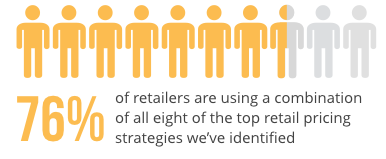
Gordon Russell, CEO and founder of cloud-based point-of-sale (POS) system Springboard Retail and CEO and founder of In The Pink fashion retail stores, says that In The Pink uses different pricing strategies to meet different goals.
A strategy of incremental discounts that increase with the number of items purchased (e.g., getting 20 percent off the second item purchased and 30 percent off the third) can be used if the goal is to sell more units, Russell says.
The company also uses specific promotions to drive sales of products that stores have too much of in stock.
Likewise, Alejandro Velez, founder of Doitwiser, an online retailer, says that his company uses bundling, discount, price lining and odd pricing all together.
“We use different strategies because our customers are not just one solid segment of people in the market,” Velez explains.
For example, Velez says, if the product is ink for a particular printer, the target market would be customers who purchased that printer in the past, which might include college students, accounting offices or small businesses. Depending on which customers purchased the printer, different pricing strategies are used to attract them.
The Software Behind the Strategies
We also asked retailers how they manage the pricing strategy (or strategies) they’re using. We found that of those using software, 43 percent are using features within their POS systems.
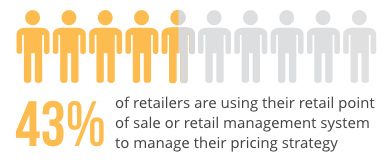
More specifically, retailers are using the reporting and analytics capabilities offered in their POS systems to analyze the various pricing strategies they use. These features tell retailers which products are selling the best and gives them insight into which pricing strategies are being used for each transaction.
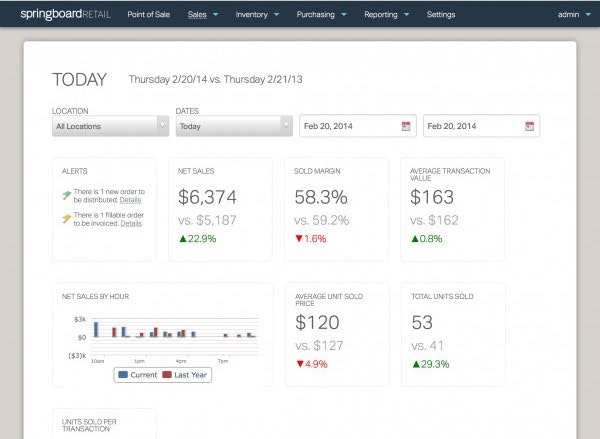

An example of a reporting and analytics dashboard from Springboard Retail
In a previous Software Advice report where we listed the top five must-have retail POS features, we highlighted the benefits of reporting and analytics, which can provide transparency into your sales to help spot trends.
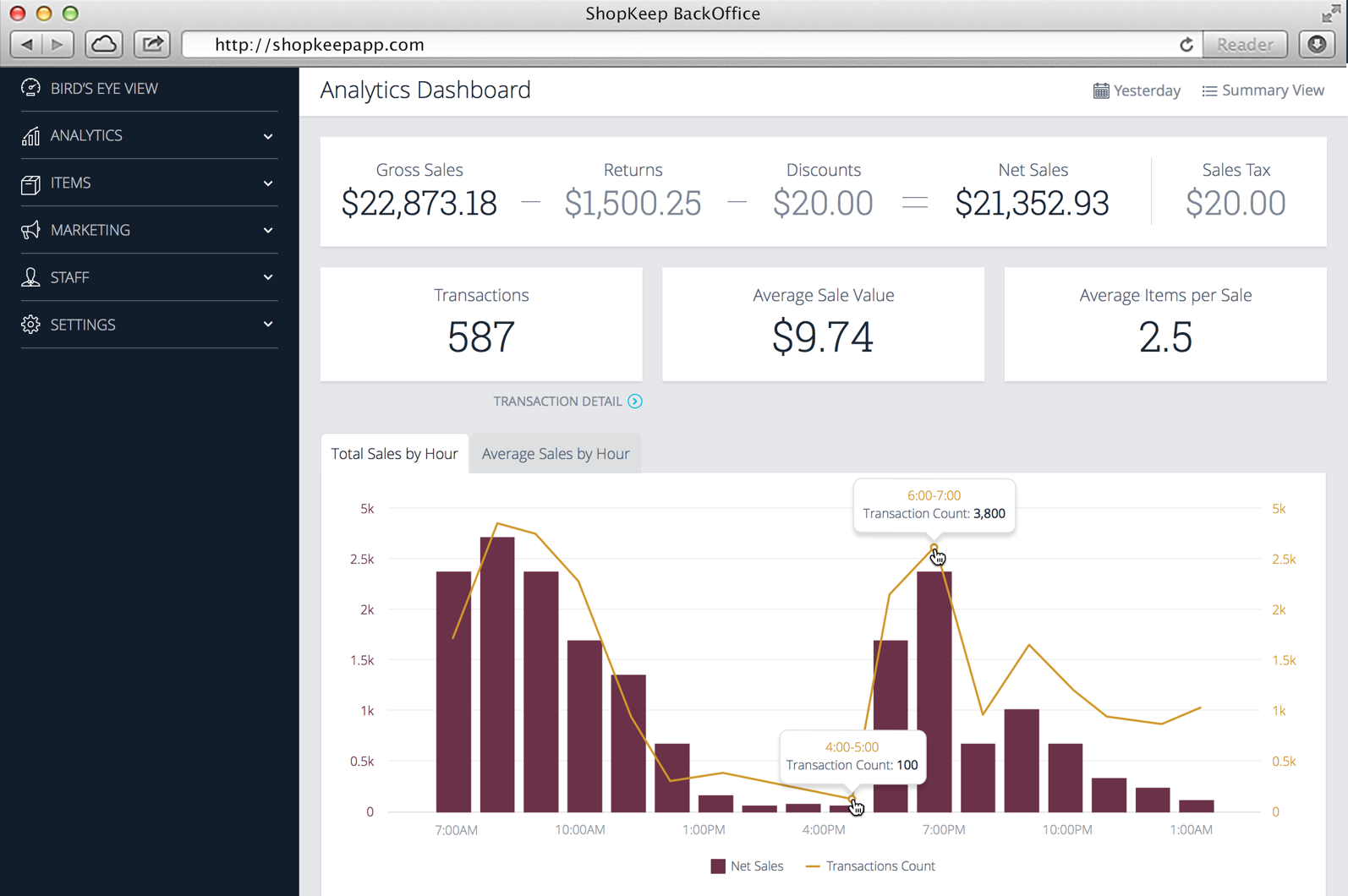

An example of a reporting and analytics dashboard from ShopKeep POS
Our analysis for this article found that 49 percent of POS buyers request sales reporting and analytics capabilities in their new POS system.
Sales reporting and analytics features from the newest generation of POS systems can provide real-time sales, inventory and promotions data, which can lead to more informed decisions about pricing.
“That’s pretty significant,” says Drew Schwartz, vice president of product at ShopKeep, a POS system started by a former merchant that focuses on small and independent businesses.
This type of real-time data and functionality hasn’t been available for very long for retailers, he explains, which means smaller companies now have an advantage few have seen in the past.
For example, ShopKeep allows retailers to track specific promotions and prices over time to determine the effectiveness of certain pricing strategies. The software also has functions to track multiple stores to see how one store might be operating differently, or to test out different prices.
Despite the value that POS systems can offer via reporting and analytics features, among many others, we’re surprised to find that 50 percent of single-store retailers still don’t have a POS system in place.
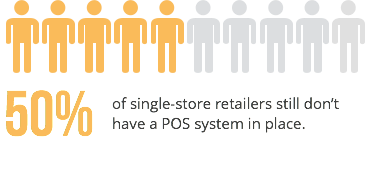
Without a POS system, managing multiple pricing strategies becomes nearly impossible. But simply purchasing a new system is only the first step: Once you have it in place, which pricing strategy or strategies should you choose?
What’s the Most Popular Retail Pricing Strategy?
Our research found that discount pricing is the most popular pricing strategy, used by 99 percent of respondents.
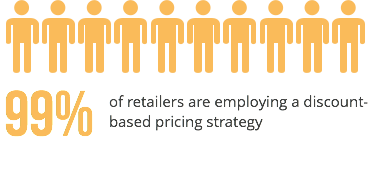
Russell says that the reason for the dominance of this strategy is straightforward:
“Everybody wants a bargain.”
This isn’t an exaggeration—retailers across sectors responded with high praise for the effectiveness of discount pricing. Here are the percentages of retailers claiming that discount pricing is “very effective” or “extremely effective”:
75 percent of general retailers
57 percent of e-commerce retailers
67 percent of specialty retailers
87 percent of grocery retailers
For general retailers, the next most effective pricing strategies are below competition and bundling; rated as “extremely effective” by 40 and 27 percent, respectively. Similar to the discount strategy, these strategies function by presenting a bargain to customers.
E-commerce retailers also find below competition and bundling highly effective, with 40 and 32 percent saying they are “extremely effective.”
Velez of Doitwiser says that bundling is one of his store’s most effective strategies. For example, Doitwiser sells water bottles for $19.75 each, but the price drops to $18.76 per bottle when three or more are purchased.
Bundling, he says, conveys a sense of value through the savings the customer receives on each item by buying in bulk.
Next Steps
Now that you’ve learned what your peers have identified as the most effective pricing strategies, the next step is to implement them in your business. But in order to do so, it’s crucial that you have the right software in place to successfully monitor and analyze your sales.
If you’re like half of single-store retailers, you’ll need to adopt a POS system for the first time.
Here are three steps you can take to get started:
Speak to a POS expert by calling (855) 998-8505. Our retail POS advisors are here to provide a free, no-obligation consultation to help you narrow down your selection to a few systems that best meet your needs.
Take our online retail questionnaire. The retail POS selection process can be rather intimidating at first, but answering these simple questions helps us help you create a shortlist of POS systems to evaluate.
Read peer reviews of POS systems. After you’ve created your shortlist, read reviews left by your retailer peers. These reviews are as valuable in providing first-hand feedback on the effectiveness of a new POS solution.